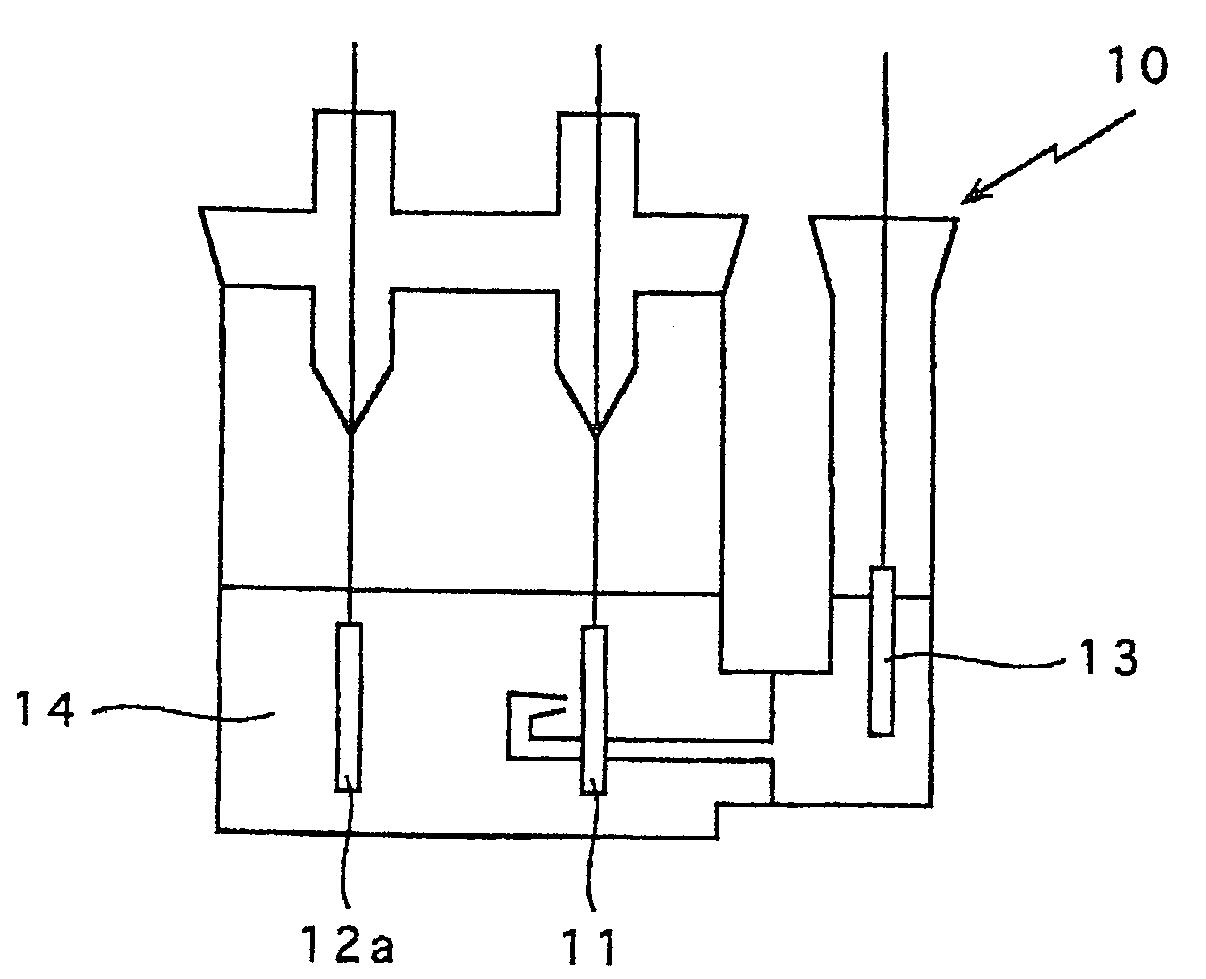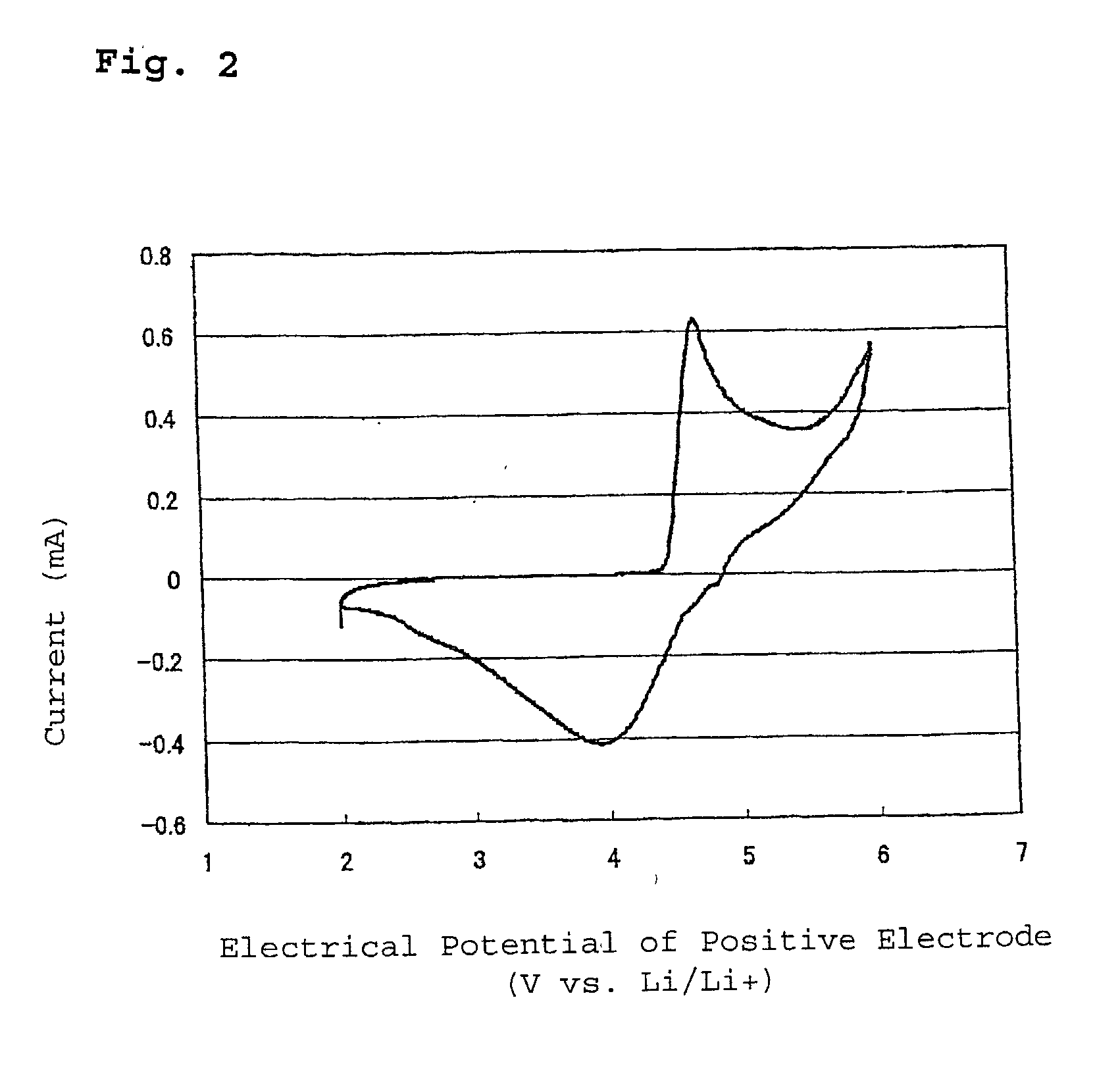Non aqueous electrolyte secondary battery
- Summary
- Abstract
- Description
- Claims
- Application Information
AI Technical Summary
Benefits of technology
Problems solved by technology
Method used
Image
Examples
example 1
[0031] In this example, a non aqueous electrolyte in which LiN(CF.sub.3SO.sub.2).sub.2 as a lithium salt was added in an amount of 1 mol / l to trimethyloctyl ammonium.trifluoromethanesulfonimide ((CH.sub.3).sub.3N.sup.+(C.sub.8H.sub.17) N.sup.-(CF.sub.3SO.sub.2).sub.2-) as a room temperature molten salt was used.
[0032] A natural graphite having an average particle diameter of 18 .mu.m, a true density of 2.20 g / cm.sup.3, a specific surface area of 6.3 m.sup.2 / g, d.sub.002 of 3.35 .ANG. and Lc (size in a direction of the c-axis) of 100 nm was used as a material for a positive electrode that is capable of occluding and discharging anions. Polyfluorovinylidene dissolved in N-methyl-2-pyrrolidone as a binding agent was added to the natural graphite in a ratio of the graphite to polyfluorovinylidene of 85:15 by weight. They were mixed to make a slurry in a mortar. The slurry was coated on an aluminum film, and dried at 110.degree. C. to prepare a positive electrode of 2 cm.times.2 cm.
[0033...
example 2
[0036] In this example, a non aqueous electrolyte in which LiN(CF.sub.3SO.sub.2).sub.2 as a lithium salt was added in an amount of 1 mol / l to trimethyloctyl ammonium.trifluoromethanesulfonimide ((CH.sub.3).sub.3N.sup.+(C.sub.8H.sub.17) N.sup.-(CF.sub.3SO.sub.2).sub.2-) as a room temperature molten salt was also used.
[0037] To prepare a negative electrode the same natural graphite as used in Example 1 was used as a material that is capable of occluding and discharging cations. Polyfluorovinylidene dissolved in N-methyl-2-pyrrolidone as a binding agent was added to the natural graphite in a ratio of the graphite to polyfluorovinylidene of 85:15 by weight. They were mixed to make a slurry in a mortar. The slurry was coated on a copper film, and dried at 110.degree. C. to prepare a negative electrode of 2 cm.times.2 cm.
[0038] As shown in FIG. 3, the non aqueous electrolyte 14 was poured in a test cell container 10, the negative electrode 12 prepared above as a working electrode, a posit...
example 3
[0042] In this example, a non aqueous electrolyte in which LiN(CF.sub.3SO.sub.2).sub.2 as a lithium salt was added in an amount of 1 mol / l to trimethyloctyl ammonium.trifluoromethanesulfonimide ((CH.sub.3).sub.3N.sup.+(C.sub.8H.sub.17) N.sup.-(CF.sub.3SO.sub.2).sub.2-) as a room temperature molten salt was also used.
[0043] Silicon was used as a material for a negative electrode that is capable of occluding and discharging cations to prepare a negative electrode. An amorphous silicon coating was formed by sputtering on the surface of a copper film, which surface was treated by electrolysis, to prepare the negative electrode of 2 cm.times.2 cm.
[0044] As shown in FIG. 3, a test cell was prepared in the same manner as Example 2 except that the negative electrode was prepared above was used. The non aqueous electrolyte 14 was poured in a test cell container 10, the negative electrode 12 prepared above was used as a working electrode. Lithium metal was used for the positive electrode 11a ...
PUM
 Login to View More
Login to View More Abstract
Description
Claims
Application Information
 Login to View More
Login to View More - R&D
- Intellectual Property
- Life Sciences
- Materials
- Tech Scout
- Unparalleled Data Quality
- Higher Quality Content
- 60% Fewer Hallucinations
Browse by: Latest US Patents, China's latest patents, Technical Efficacy Thesaurus, Application Domain, Technology Topic, Popular Technical Reports.
© 2025 PatSnap. All rights reserved.Legal|Privacy policy|Modern Slavery Act Transparency Statement|Sitemap|About US| Contact US: help@patsnap.com



